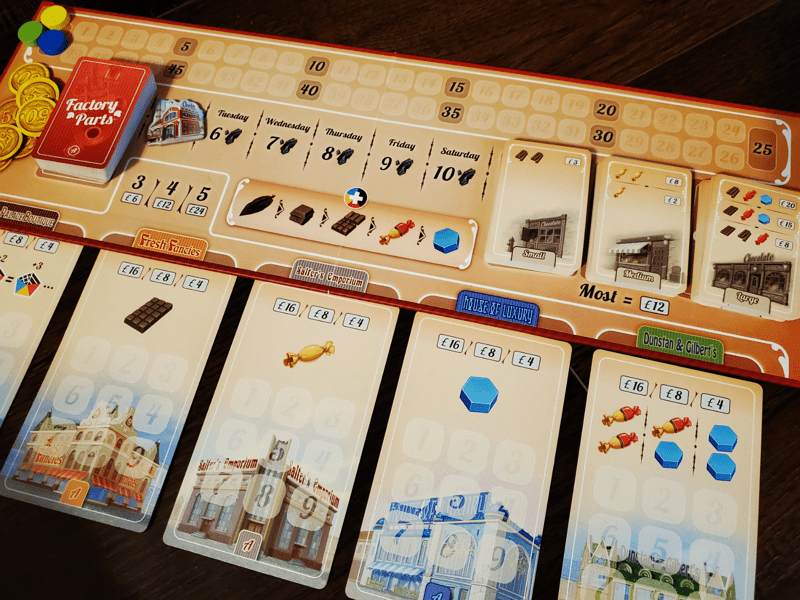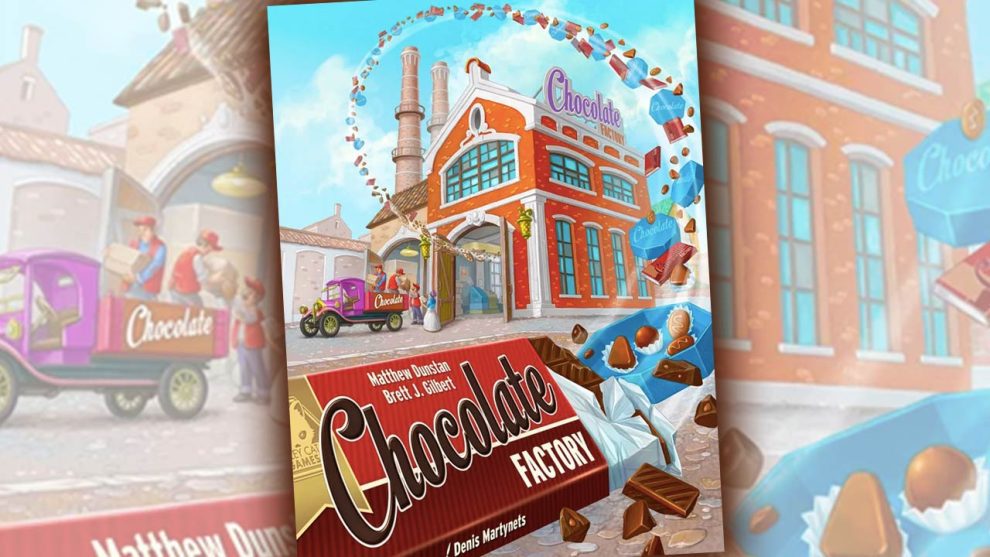If you were to scour our house right now for chocolates, you would find them in the pantry, the freezer, the office/classroom, and, likely, hidden away in the kids’ bedrooms. Where you would not find them is in the coal cellar. In part, this is because we don’t have a coal cellar (though—fun fact—some of our neighbors do). But also, because why would you store chocolate in a coal cellar?
Apparently this is more common than I thought, because that’s precisely where the sweets are stored in Chocolate Factory.
Chocolate Factory comes from Alley Cat Games and the design team of Matthew Dunstan and Brett J. Gilbert (Elysium, The Gardens). Players take up the role of chocolatiers in a competitive marketplace to produce and sell their wares to the right shop at the right moment. Along the way, yes, the chocolate is stored right there with the coal, dirty floor and all—a seemingly unusual thematic decision. I suppose I can let it slide, as long as the game is good.
Prepare, Expand, Recruit
In a very real sense, the most pivotal action in Chocolate Factory is the one that takes the least time by comparison. Having collected an allotment of Coal, each day begins with a two-round Packet Draft in which players draw an Employee for the day and a new Part for their factory. The cards are formed into a combination of both “Packets”—multiple cards—and singles. When a player drafts a Packet, they keep one and discard the other. While this sounds simple, the mechanism adds an interesting layer of pseudo-interaction, as the discard feels as much like a block against others as it does a self-interested grab. The best choice will simultaneously hinder and help through the knowledge of what might have been.

Employees serve two purposes for the current day. First, they bring their special skill to the fore, granting an ability or one-off blessing. Second, they bring their networking skill which creates an opportunity for sales to a specific Department Store. More on that in a moment.
Factory Parts are permanently installed as stops along the factory floor which modify and enhance the chocolate-making process. Former Parts may be covered but never moved.
Operate
Each player’s factory consists of a galley with room for four Parts on either side of the conveyor. The double-layered board contains a recessed path through which the conveyor tiles slide, each carrying chocolatey goodness in the process. The day is broken into three simultaneously played Shifts during which a new bean is loaded onto a conveyor tile and pushed into the machine. With each movement, tiles match up with new Factory Parts. By spending a bit of coal, players may then activate Parts to transform the beans into cocoa, into bars, and into the sorts of wrapped delights you might see on the shelves of your favorite old-timey corner store (or possibly your coal cellar, you weirdo).

At the outset, each Factory is equipped for simple choco-upgrades. But the drafted Parts really carry the day here, especially as the deck progresses and the upgrades become more potent. There are five steps in the chocolate-ing process. Some Factory Parts skip steps altogether, magically morphing a chunk of cocoa into a host of finished products. Others duplicate and triplicate the product. Every stop in the Factory is useful, but the daily limit of Coal determines what is possible.
Creating an opportunity for the efficient player, an early-exit Chute stands waiting to yank finished product from the factory floor two steps early for timely sales. The Chute is perhaps the most critical Part of the process because a bean could conceivably be converted to its final form and exported in a single day if the Coal, Employees, and Parts (and maybe the stars?) align.
Sell, Sell, Sell
At the end of the day’s three Shifts, sales of finished chocolate are divided between private Corner Shops and public Department Stores.
Each player has ready access to a small, medium, and large Corner Shop consisting of one, two, and three orders, respectively. These are effectively cash shops that pay upon delivery. When all the orders on a given Corner Shop are fulfilled, a new Shop joins the mix. At the end of the game, the player who satisfies the most individual shops will gain a bonus. Chasing a run of small shops might mean less cash per shop, but a better shot at the bonus. Fulfilling a large shop over a few rounds, though, will provide 6-8x as much cash as one small shop. There are viable options before we even talk about Department Stores.

There are five Department Stores on the central board that pay, not according to the individual order, but according to the most established presence within. Sales here move trackers during the game, and the players score payment at the end of the game based on their position on the track. The first place player receives a hefty payment. Second place pays ONLY if they’ve moved at least half as far as first place. The condition then cascades down, with third place needing to reach half of second place. The real catch here: players can only sell to a Department Store if they have an Employee with the right connection. Did I mention the importance of that little Packet draft at the beginning of the day?
The Finish Line
There are six work days in the week. Normally there is a brief clean-up to remove spent Coal, bring the conveyor tiles back to the front end of the factory, dismiss Employees, and replenish the fulfilled Corner Shops. Two finished chocolates may carry over to the next day and are tucked away in that dingy coal storage room.
The bulk of movement on the cash scoreboard takes place at the end of the game. After that Corner Shop bonus is awarded, players move through the Department stores gaining the spoils of their timely labors. After one final bonus based on the number of Department Stores into which each player sold goods, the player with the most money wins.
Taste Test
Beginning with the most obvious, Chocolate Factory is a gem in aesthetics and overall table presence. Pushing the conveyor tiles through the double-layer factory board is so very satisfying. Likewise, the wooden chocolate bits are fun to swap out as they mature from the lowly bean to the bank account. The coal bits are fun to toss around as well, making this game loads of tactile fun. The artwork speaks of a bygone era of soda fountains and after-school stops at the local sweets shop. Clearly, Alley Cat spent money in the right places to give this title a bit of memorable heft.
When it comes to gameplay, I cannot stress enough the weight of the Packet draft. The decision involves a knowledge of the current state of the factory and the public square, as players will need the right Employee if they intend to sell to the Department Stores that day (and if they want to keep their opponents from doing the same). Of course, the Employee’s ability should ideally help that cause through a bonus of coal or greater efficiency in the machine or in sales. Or maybe the Factory Part will take precedence that day when a coveted converter or duplicator rears its head. Players can draft from either row with their first selection. With the draft snaking back for a second round, though, the decision also involves weighing which card is more important, which card is less likely to remain next time around. I love the draft. Two cards generate a lot of stress.
Once the Parts and Employees are in place, oddly enough, there is far less sweat inside the factory. There will be three Shifts, three moves to consider. There is only so much that can be done with the allotted Coal. In fact, the need for cost-effective Parts just puts that much more importance on the draft. The idea is to create an engine that will serve the initial draw of Corner Shops and Department Stores, and then to gear the remaining choices to improve that engine. At six rounds, Chocolate Factory is just long enough that the engine never becomes stale in its repetition. Each day’s draft presents valuable and energizing opportunities to move towards the goal.
Both the draft and the Corner Shops introduce a bit of luck to the equation. The entirety of the challenge—and the fun—in Chocolate Factory’s draft resides in responding to the gold and the dross that rises each morning in the form of those pesky Packets. Frankly, I want the randomness there. The Corner Shops could be a bit more frustrating if a strategy is interrupted by a run of shops that just don’t want what a factory is producing. I’ve yet to be bothered, but the game would work just as well to draw two and choose one to introduce some agency.
The quantity of available Coal is the other delightful source of tension throughout the game. As the week progresses, each successive day brings one more piece of Coal than the day before. But there are very few Factory Parts that operate for only one of the black rocks, creating the need for wider and greater capacity inside the machine. At the risk of sounding like a broken record, see the draft above, especially the mention of Employees who bring an extra bucket of Coal.
The various Shops and Department Stores present some interesting decisions within the game. To sell out a half dozen small and medium Corner Shops might mean £45 and the £12 bonus. Selling out even two large shops could mean £60 or more, though it’s more difficult than you might think. Each Department store offers £16 to the first place chocolatier, £8 to second, and £4 to the third, but you have to keep up. Plus, getting into multiple Department stores equals another £6, £12, or even £24 bonus at the game’s end if you spread the net wide enough. There is a balance among these options and, therefore, variety among the strategies. But it is wise to tailor the factory toward a particular end. I commend that sort of thoughtfulness in the design.
Once there is adequate familiarity with the game, there is no reason not to play both the Operation phase and the Sales phase simultaneously. I know this sets teeth on edge for some in fear that others will make mistakes (sometimes intentionally), and I know this pushes the game into a more solitary experience, but such is the nature of this chocolate biz. Trust me, you don’t want the downtime. Operating the factory is a heads-down activity, but with all the hands reaching this way and that to swap chocolates, you’ll know you’re not alone. In the Sales phase, likewise, there is so much reaching and verbalizing the orders being fulfilled, you’ll have eyes and ears all around. And you’ll definitely come to attention as the next day’s draftees are revealed.
Because of the simultaneous format, player count is almost a non-factor here—certainly with regard to time. The challenge of keeping up in the Department Stores is easier at the higher player counts. Because of the number of tokens involved, there is a greater likelihood that someone will keep up with that tricky “must maintain a distance of half” bit, keeping the cascade intact. Lower player counts open the door to runaways inside individual stores, especially if the other player keeps to the Corner Shops. But there is balance overall.

Broadly speaking, Chocolate Factory is another rock solid offering from Alley Cat. Their reprint of Tinners’ Trail is one of my favorite games of the last few years, so my expectations were impossibly high when I cracked the shrink on the box. But they’ve managed to deliver a lovely game once again. For the chocolate lover, this might just be the right box of goodies. Where there is interaction, it is enjoyable. The limitations of the Coal, Employees, and Factory Parts are to be celebrated as highlights. And, of course, the conveyor was a brilliant idea, a feast for the fingertips sliding those beans into the machine.
If you find yourself leaning toward this one, I don’t think you’ll have regrets grabbing a copy. Chocolate Factory delivers—just make sure you sweep up the coal cellar.












Add Comment